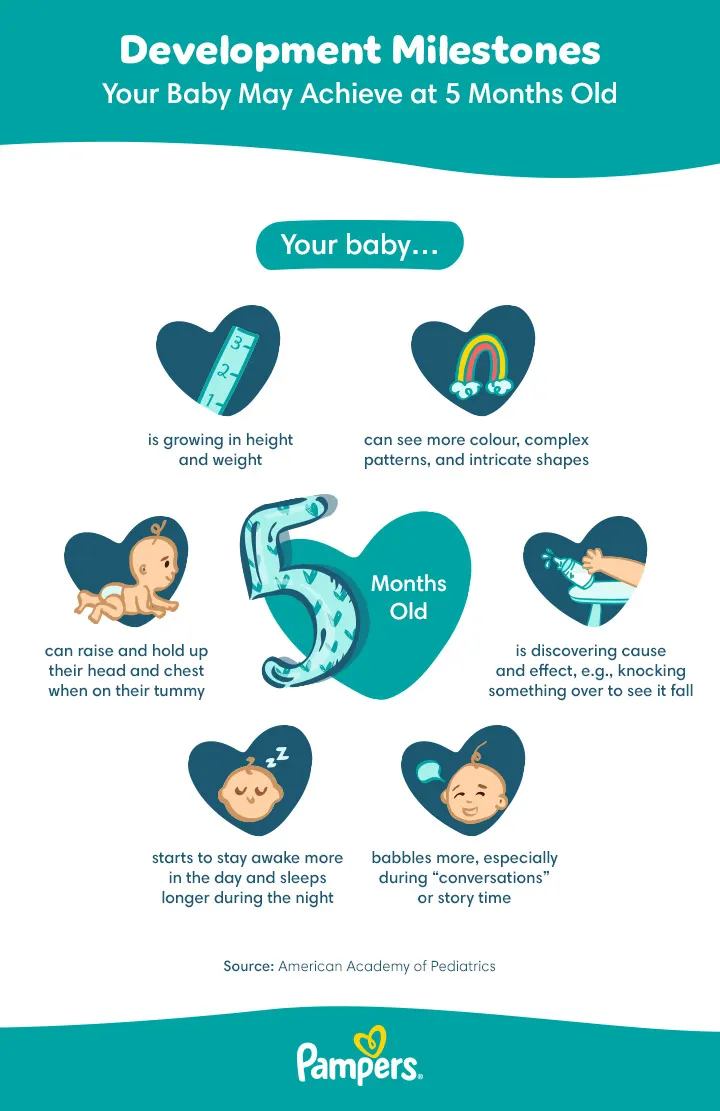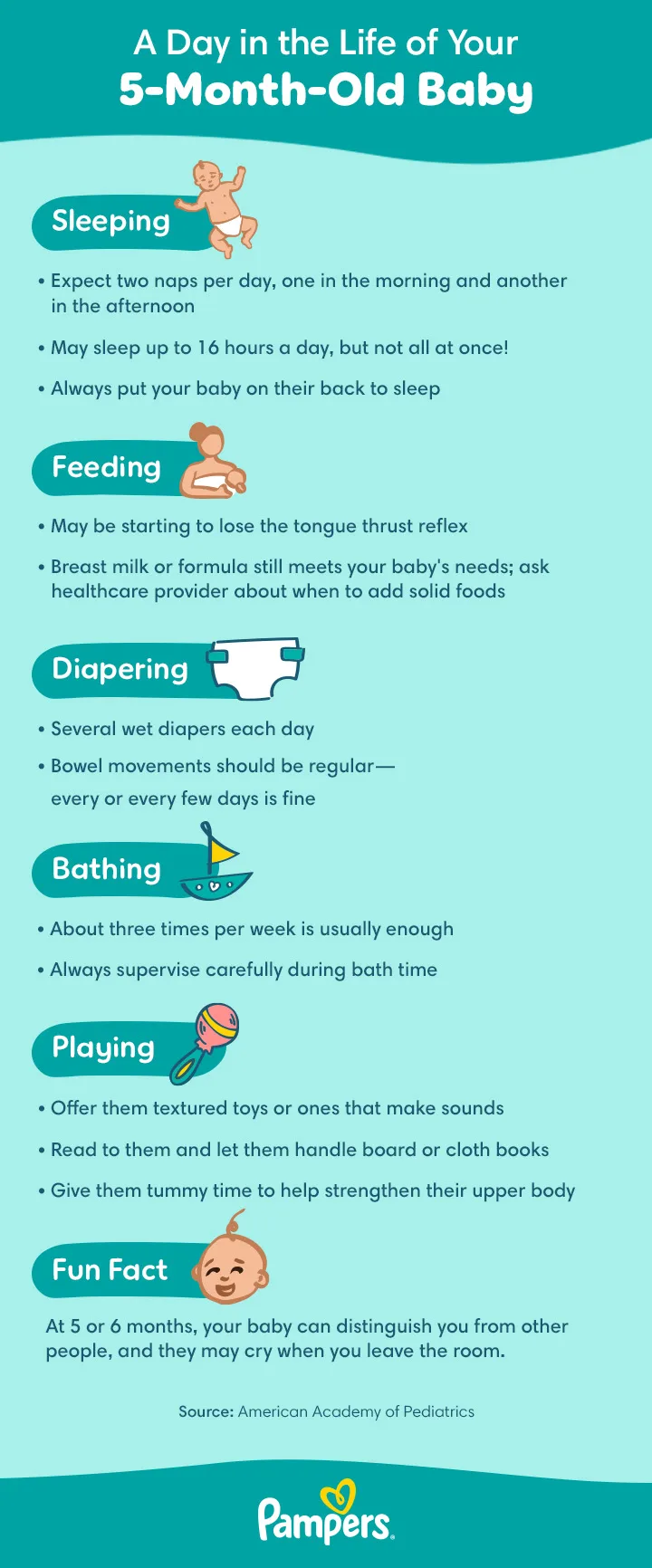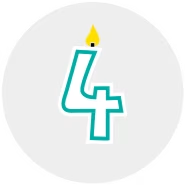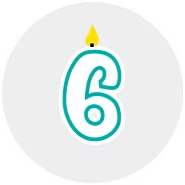Your 5-Month-Old Baby's Development and Milestones
At 5 months old, your little one is getting stronger, more expressive, and increasingly curious about the world.If you're wondering what a 5-month-old should be doing, here are some of the most common developments to look for at this stage:
Growth. Many babies double their birth weight around this time and grow steadily in length.
Eyesight and sensory skills. Your baby may now see several feet away and recognize familiar faces across the room. They may prefer bright colours and show more interest in bold shapes and patterns.
Movement. Improved core strength allows your baby to hold their head and chest up during tummy time, push up on arms, and maybe even roll over.
Intellectual development. Your baby may start to understand simple cause and effect (like dropping a toy to see what happens). They're becoming more socially aware and love hearing your voice, looking at books, and babbling in response.
Activities. Tummy time, picture books, play mats, and activities to do with a 5-month-old, like peekaboo or toy exploration, may support both movement and brain development.
Feeding. Most babies drink 24–36 ounces of breast milk or formula daily.
Diapering. Expect about 6 or more wet diapers daily.
Sleep. Babies typically sleep 12–16 hours a day, including 2 to 3 naps. Some may experience changes in sleep patterns tied to a 5-month sleep regression or new developmental milestones.
Health and wellness. Teething often begins this month, and it’s normal to see extra drooling, crankiness, or chewing.
Learn more with our guide, as it explores each of these areas in more detail and offers gentle, expert-backed suggestions to help you support your baby’s development this month.
Baby Development Milestones
This stage is full of exciting developments as your little one gains strength, coordination, and a growing curiosity about the world. From improved vision to more purposeful movements, each small change supports their overall growth and learning.
Of course, every baby develops at their own pace. These milestones are more of a guide than a checklist—progress matters more than precise timing. If you ever have concerns, your baby’s healthcare provider is your best resource.
Let’s explore what this month may bring across a few key areas of development.
What Should a 5-Month-Old Be Doing?
By now, you may have settled into a rhythm that works well for you and your baby. But if you're still wondering what a 5-month-old should be doing, or if your little one is still at 4 months and you're curious about what's coming next, here’s a quick look at what your baby’s day might include.
At this stage, your little one may be building new skills like rolling, babbling, reaching for toys, and showing more interest in their surroundings. Their days are likely filled with naps, feeds, diaper changes, and lots of play and interaction.
Next up, we’ll dive into what this means when it comes to feeding, diapering, sleep, and overall health, so keep reading for a more detailed look.
Weight and Height of a 5-Month-Old
By the time your baby reaches 5 months, they’ve likely come a long way from their newborn days. While every baby grows at their own unique pace, many double their birth weight around this time.
You may be wondering, “How much should a 5-month-old weigh? ”. This month, your little one will typically gain about 1¼ pounds and grow around 0. 8 inches in length. The average height for a 5-month-old also varies, which is why your baby’s healthcare provider will track their progress on a baby growth chart to ensure they’re growing steadily, not according to a specific number.
It’s also common for babies to experience a 5-month growth spurt. These short phases of rapid change in weight and length are part of typical development and can happen several times in the first year. During a growth spurt , your little one might seem hungrier, fussier, or sleepier than usual. These are all signs that their body is working hard behind the scenes.
Curious to see how your baby’s growth compares over time? Try our Growth Chart Calculator to track their progress in a clear, simple way.
Movement: Building Stronger Core Muscles
Your baby is getting stronger every day, and they’re working hard to build those all-important core muscles. Around 5 months, many babies can raise and hold their head and chest up steadily while lying on their tummy. Some may even start pushing up higher using their arms or begin rocking side to side.
You might notice your baby kicking their legs with more intention or pivoting slightly during tummy time. These movements may seem small, but they’re major building blocks that lead to future milestones like rolling over and eventually crawling.
Can babies crawl at 5 months? It’s a little early for most, but the foundational skills are in progress. Babies typically begin crawling closer to 6 or 7 months , but every baby moves at their own pace. For now, offering plenty of tummy time is one of the best ways to help strengthen your little one’s neck, back, and abdominal muscles.
Intellectual Development of a 5-Month-Old
Your little one is rapidly learning from every sound, sight, and interaction. The intellectual development of a 5-month-old baby includes beginning to understand cause and effect—like kicking the mattress to see it move, or dropping a toy and watching you pick it up. These simple experiments help your baby learn how their actions can influence the world around them.
While this repetition may test your patience, it supports their early memory and problem-solving skills. As long as it’s safe, let them explore—just keep choking hazards, sharp items, and breakables out of reach. Your little one’s curiosity is also linked to early problem-solving and memory skills. As their brain continues developing, they’ll start recognizing familiar faces, responding to your voice, and showing excitement when routines become familiar.
At the same time, their vision is getting sharper. So, how far can a 5-month-old see ? By now, they can see several feet away—farther than in their earlier months—and they’re starting to recognize familiar faces and objects from across the room. Their ability to focus continues to improve, making it easier for them to track moving objects and reach for things with more purpose. Their focus and depth perception are sharper, helping them track movement and reach more purposefully.
You can support this cognitive and visual growth by offering picture books with bold patterns, describing what you see during walks, and talking directly to your baby. Pause to let them babble back. Over time, your little one will get better at mimicking sounds and may even form early syllables as they prepare for those exciting first words .
Activities for Supporting Your 5-Month-Old Baby's Development
Your 5-month-old is gaining strength, coordination, and curiosity every day. Encouraging movement and interaction through daily routines is one of the best ways to support their growth.
One of the most beneficial 5-month-old activities is tummy time . Try doing these two or three times a day while your baby is awake and supervised to help build strong neck, back, and shoulder muscles.
Here are a few more simple ways to help your little one learn and connect:
Play daily. Make funny faces, play peekaboo, shake a rattle, or show them new toys. You can play during diaper changes, bath time, or neighbourhood walks.
Talk and sing. Respond to their babbling, narrate your day, or sing a familiar tune. These back-and-forth moments help build language skills.
Read together. Picture books with bold colours and large images are great for visual and language development.
Encourage social time. Let your baby meet other parents or babies if they seem comfortable. Just watch for signs of overstimulation.
Explore textures and sounds. Give your little one toys that crinkle, rattle, or feel interesting—they’ll love experimenting with new sensations.
These early interactions aren’t just fun—they support your baby’s brain, body, and social-emotional growth.
Diapering and Pooping at 5 Months Old
Your baby’s feeding routine often goes hand in hand with diaper changes, and at 5 months, you may be getting pretty familiar with both.
So, how many wet diapers should a 5-month-old have each day? While the exact number can vary, a baby should have several wet diapers a day and regular bowel movements, as long as the poop is soft. If it becomes hard, dry, or difficult to pass, let your healthcare provider know.
As long as your little one’s stool is soft and they're feeding well, there’s usually no cause for concern. Keep an eye on consistency and comfort rather than a strict number of bowel movements.
Alongside tracking output, it's also a good time to think about the best diaper fit for your baby. A snug but comfortable fit helps prevent leaks and keeps your little one dry during all that active play. If you're unsure where to start, check out Pampers Swaddlers , which are designed to offer softness, flexibility, and reliable protection for growing babies.
How Much and How Often Should a 5-Month-Old Eat?
At 5 months, your baby might be showing more interest in what you're eating—staring at your plate, opening their mouth when a spoon comes near, or trying to grab food. So, what do babies eat at 5 months old?
Breast milk or formula is still your baby’s primary source of nutrition. However, some parents may consider baby-led weaning at 5 months, which involves offering very soft finger foods instead of purees. This approach is usually better suited for babies closer to 6 months, when they have stronger head and trunk control.
If your little one is starting to sit up with support and has lost the tongue-thrust reflex, they may be ready to try small amounts of solids. Traditionally, single-grain infant cereals have been among the first foods offered, but you could also begin with pureed vegetables or fruits. Always check with your baby’s healthcare provider before introducing solids or trying a new feeding method.
You may also wonder, how much should a 5-month-old eat? Most babies at this stage drink about 4 to 6 ounces of breast milk or formula per feeding, though some may take more depending on their appetite. That typically adds up to 24 to 36 ounces per day, spread over several feedings.
As for how often a 5-month-old should eat, many babies follow a loose rhythm of feeding every 3 to 4 hours. However, appetite can vary from day to day, and during a growth spurt, your little one might want to feed more frequently or take in larger amounts.
Not sure where your little one’s feeding schedule fits in? Take a look at the baby feeding schedule below for a quick visual overview of how feeding patterns typically change from birth through 12 months . It can help you understand where your 5-month-old might be—and what’s coming next!
Feeding changes often come with diaper changes, so next, we’ll look at what’s typical for your baby’s digestion and output at this stage.
A 5-Month-Old’s Sleep: How Much Sleep Does Your Baby Need?
Just like feeding and diapering, sleep is an essential part of your little one’s routine—and at 5 months, you may be wondering how much rest they truly need.
Most babies this age get about 12 to 16 hours of sleep in a 24-hour period. This includes a longer stretch of nighttime sleep (possibly with fewer wakeups) and a few hours of daytime sleep spread across naps.
So, how many naps does a 5-month-old need? Usually, about two to three naps per day, adding up to around three to four hours total. It's also helpful to pay attention to how much daytime sleep for a 5-month-old works best for your baby, as every child’s sleep needs are slightly different.
You might also be thinking about what time a 5-month-old should go to bed. Many babies settle well between 7:00 PM and 8:30 PM, but it depends on your little one’s temperament and overall schedule. Watch for sleep cues like eye rubbing, yawning, or fussiness to guide you.
If your little one’s sleep suddenly changes, with more night wakings, shorter naps, or extra fussiness, you might be dealing with a 5-month sleep regression. Although there isn’t a specific regression tied to this exact age, many babies are still adjusting after the well-known 4-month sleep regression , when sleep cycles begin to mature.
Around 5 months, your baby may also be practicing new skills like rolling or sitting, or going through a growth spurt—all of which can contribute to a 5-month-old sleep regression. Learn more about what to expect and how to support your baby through it in this helpful sleep regression guide .
If your little one is having a tough time getting rest, our Smart Sleep Coach app offers expert-backed advice and custom bedtime recommendations to help you both get better sleep.
Why Is My 5-Month-Old So Fussy?
Why is my 5-month-old so fussy? Fussiness at this age can stem from teething, tiredness, hunger, or a growth spurt. Your baby may also be more aware of their surroundings, which can lead to overstimulation. Try soothing routines and check for signs of discomfort or a change in feeding/sleep habits.
Your Baby’s Health
It’s always tough to see your baby feeling unwell or crying in discomfort. As a parent, you do everything you can to keep them healthy and safe, but even with the best care, occasional illness or discomfort is a normal part of development.
A common health concerns that may affect your 5-month-old this month:
Conjunctivitis (Pinkeye). Conjunctivitis causes red, inflamed eyes, especially in the whites and inner eyelids. It’s often itchy, uncomfortable, and can last a week or two. While usually caused by a virus or bacteria, conjunctivitis can also result from allergies or irritants like smoke.
If you suspect your little one has an eye infection, consult their healthcare provider, as treatment may be needed. Because conjunctivitis is highly contagious, you should wash your hands thoroughly before and after touching your baby’s eyes or applying any medication. If your baby attends childcare, it’s usually best to keep them home until the infection clears.
Items You Will Need This Month
As your little one is nearly 6 months, they may be more active, curious, and eager to explore.Here’s a helpful checklist of things to do this month to support their development and keep them safe:
Take a fresh look at babyproofing your home. Your little one may be close to rolling, scooting, or even crawling.Use this babyproofing guide to spot potential hazards:
Tuck away cords and cables
Secure heavy furniture or décor that might pull off
Cover the sharp edges of tables or shelves
Consider installing baby gates near stairs or off-limits rooms.
Start prepping for your baby’s 6-month checkup. If you have questions about sleep, feeding, development, or vaccines, jot them down now so you’re ready for the visit.
Curious about what’s ahead? Get a sneak peek of what’s typical at 6 months old.
A teething ring made of firm rubber to help your little one with their teething.
A play mat for tummy time, age-appropriate toys with textures or sounds, and a few favourite baby books.
Childproofing basics like cabinet locks or outlet covers.
5-Month-Old Milestones Checklist
5-month-old milestones checklist: Remember that every baby develops on their own timeline, but here are some common 5-month-old milestones many parents observe around this time.
Use this checklist as a general guide to celebrate your little one’s progress and notice areas where they may need a bit more support:
Can hold head and chest up steadily during tummy time
Pushes up on arms and may rock while on tummy
May start to roll from back to tummy
Reaches for toys and brings them to their mouth
Babbles or makes vowel sounds like “ahh,” “oh,” or “eh”
Responds to familiar voices or name
Recognizes people and objects across the room
Shows interest in colourful books or patterns
May begin trying small tastes of solids (if ready)
Displays early signs of teething (drooling, fussiness, chewing).
If you have any questions or concerns about your baby’s development, your healthcare provider can offer personalized guidance and reassurance.
FAQS AT A GLANCE
Fussiness at this age can stem from teething, tiredness, hunger, or a growth spurt. Your baby may also be more aware of their surroundings, which can lead to overstimulation. Try soothing routines and check for signs of discomfort or a change in feeding/sleep habits.
The Bottom Line
Your 5-month-old is growing fast—developing new skills, showing more personality, and likely keeping you on your toes. Whether they’re reaching for toys, exploring new sounds, or starting to show signs they’re ready for solids, this is a month full of exciting changes.
Remember: every baby hits milestones on their own timeline. Use this guide to support your baby’s development, but trust your instincts, and when in doubt, your healthcare provider is your best resource.
Want to make life a little easier while tracking your baby’s growth and diapering needs? Download the Pampers Club App for helpful tools and digital offers made just for parents like you.
How We Wrote This Article The information in this article is based on expert advice found in trusted medical and government sources, such as the American Academy of Pediatrics and the American College of Obstetricians and Gynecologists. You can find a full list of sources used for this article below. The content on this page should not replace professional medical advice. Always consult medical professionals for full diagnosis and treatment.






